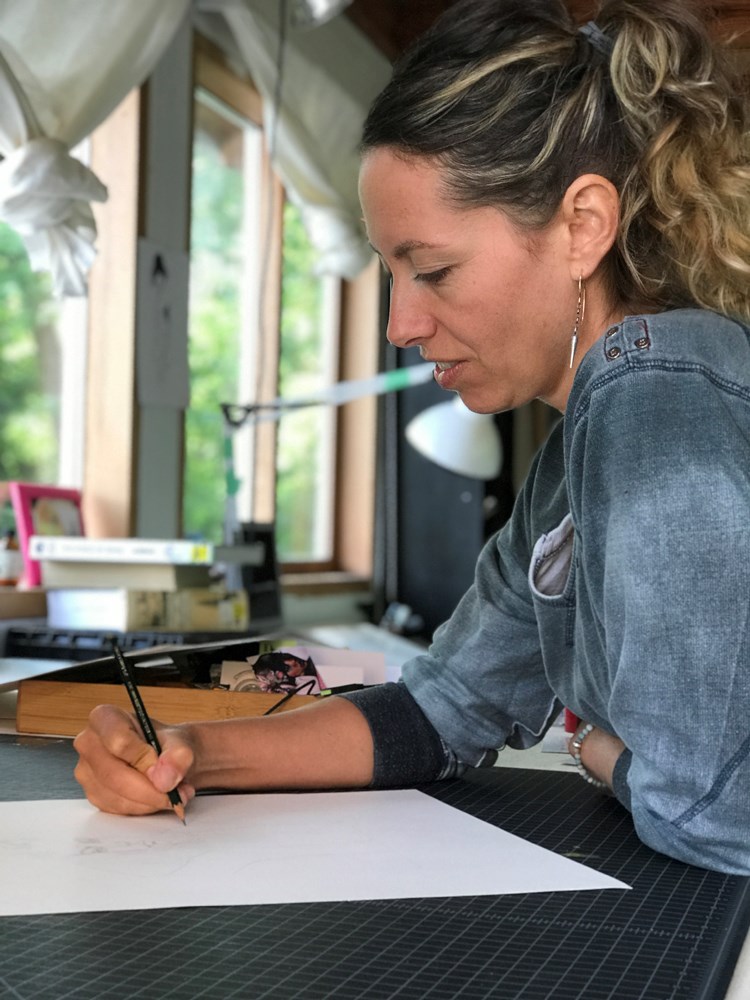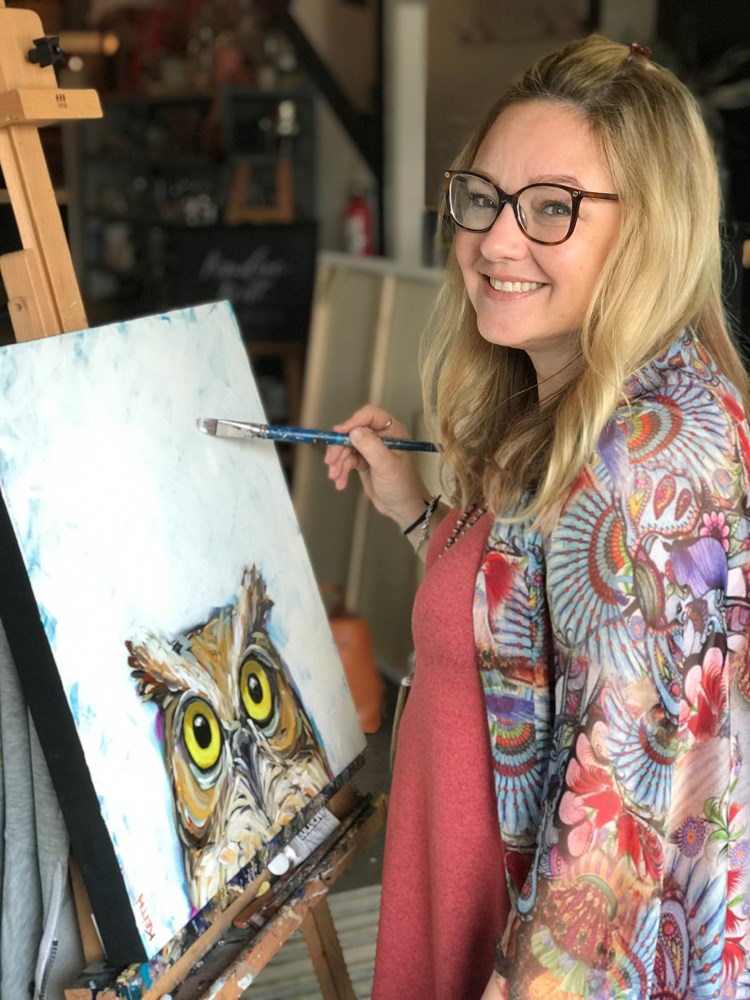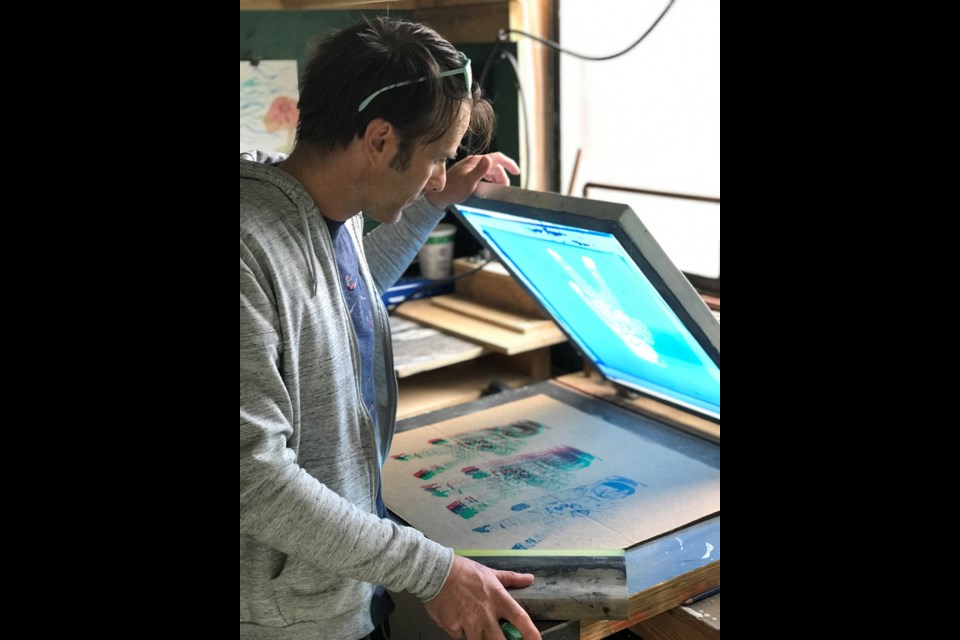Making a living as an artist in this town can be as complex and layered as the silk screening press that stencil artist Stewart Hughes is setting up inside a scrappy rented studio space in the mixed residential-commercial area of downtown at the end of Second Avenue.
In an effort to realize his dream of opening a multi-use destination gallery in Squamish, Hughes is embracing his inner mogul and rolling out Phase One of his business plan — make some money.
The idea is to produce t-shirts and other textiles with screen-printed images supplied, for the most part, by clients. They can include sports teams, schools, corporations or any number of small businesses in the Sea to Sky Corridor. Hughes can accommodate custom and small orders – anywhere from 10 and up.
“It’s a bit out of necessity, but I also have an entrepreneurial spirit that drives me to do this sort of thing. I want to build a working, profitable business; down the line I’d like to have some employees working for me to do screen printing so I can focus more on the art,” he said, detailing his idea for a gallery to include retail frontage and a space large enough to host events.
“My ultimate vision really is to have the gallery space with a couple of turntables set up, a great coffee machine with super affordable drinks so people can hang out in a comfy place and have great conversation and talk about culture. The screen press can be relocated to the back of the shop. Then we can have a gallery show once a month with art that I curate. I want to represent good art, you know? But that doesn’t necessarily make any money. This,” he says waving at the machinery behind him, “will be the bread-and-butter.”
Hughes, who has previously put a lot of time and energy into producing Versatile Gallery – a pop up gallery/event in both Vancouver and �鶹�����that sold art, pottery, clothing textiles, and jewelry produced by �鶹�����creatives, describes the screen-printing business as a stepping stone.
“This is a crossover business. I’ll have my commercial clients but I will also be able to build my own product line with my artwork,” he said, gesturing to the shirt he is wearing featuring stencil art he created. “I want to focus on a variety of textiles, including tea towels. It’s all in the details. I want to make it tight looking — packaging, and all.”

A stone’s throw away in the same neighbourhood, Lani Imre ambles around her own studio, sketching and painting the faces of strong, iconic and anime-inspired female subjects she’s become known for. For her, embracing the business side of art is as natural as putting a brush to canvas.
“Incorporating business into art is important,” she said. “I don’t imagine it’s possible to survive as an artist without also being entrepreneurial or business-minded. That doesn’t come naturally to a lot of artists; in fact, it’s definitely something we all grapple with to varying degrees. I’m fortunate in that I’m also super organized, and that supports a lot of my business-type of activities.”
Imre suggests that art schools could do a better job of training students for the experience of operating in the world of commerce by offering business courses.
“I think just the innovation of artists and creativity naturally lends itself to entrepreneurial processes. But there’s a lot of artists that lack resources and training. You’re generally focused on the art itself – which is fantastic, we need to be producing images or whatever it is that you’re working on – but we also need to focus on what it means to have a business or have a career as an artist, right?
“Right now I’m doing everything for myself. I’m just looking for ways to create new networks and anything to support the growth of my business,” said Imre, adding that she’s solely responsible for the marketing of all her work, and booking herself into festivals where she sells prints and other products besides original pieces. Ideally, she says, she would like to pass that off to someone else.
Last year, as part of her plan to build a network amongst other female artists, Imre produced an event in Vancouver at the Beaumont called Feroza, celebrating “the unity of women through self-expression, creativity, and sexuality.” It featured hung paintings and sketches, as well as live performances by First Nations dancers bringing attention to murdered and missing Indigenous women, to singer-songwriters and burlesque dancing.
“The hope was always to sell artwork, which wasn’t very successful,” she conceded. “But as an artist, I became more clear on why it is I make the images I make. I’ve had a lot of reflection on it for my own practice. The way I portray women – for me, it’s a reclamation of what we see portrayed to us culturally and in the media. What this event brought up for me is helping me understand how I can portray women’s stories even more authentically.”
Imre, who is currently in California at the Lightning In A Bottle Festival, continues to seek out new ways to cultivate her network. She’s recently joined Thrive, a group of female artists who meet online as part of the Mastermind Group.
“I love trying new things,” she said. “As an artist, there is no template, it’s just finding your own path through it all. It’s about being an entrepreneur. I am very encouraged by that. The only conflict in that is when things are taking away from the actual art production. It’s just balancing it all.”

Painter Kandice Keith, who is also a part of Thrive, operates out of her commercial studio at Bungalow 968 in the industrial park about 50 per cent of the time. There, she says she’s able to focus solely on her business and leave the day-to-day of parenting — and all that entails — behind. She also mentors two other artists still finding their legs, offers seasonal workshops, and has been putting a great deal of time into developing a website that can help her sell her line of prints, in addition to the originals she has at galleries in and around the Lower Mainland.
As a former finance professional (she worked at the Vancouver Stock Exchange, a hedge fund company, sold mutual funds, and has been a bookkeeper), Keith has excelled as an artist and become widely known for the animal images she creates. She says the business side of things comes easily for her – the difficulty is in the amount of time that takes away from creating art.
“There are a lot of similarities between art and business,” said Keith, who was recently accepted into the Federation of Canadian Artists. “Both things are about problem-solving. Art is building a puzzle and piecing it all together, and financial planning is very similar. I’m attracted to all of it.”
Her experience in the financial world clearly gives her a boost when it comes to her confidence in her art and business.
“I was always intimidated by other artists, I never went to art school — my designs are different,” she explained. “It’s kind of intimidating … you always feel like you’re a little kid showing your art. But it’s been over 15 years now. I’m getting a handle on it.”




